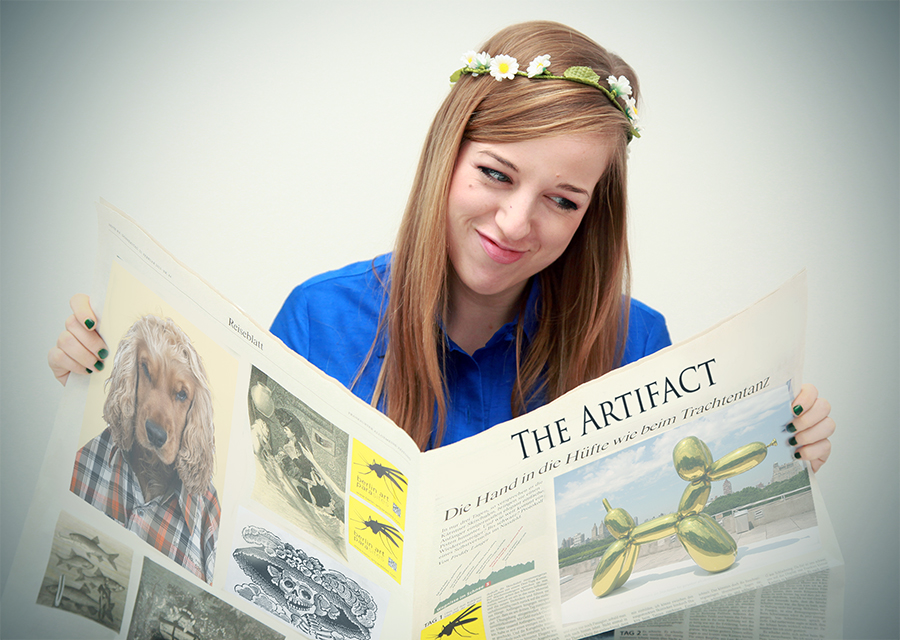Doggy Styled: Canines Take The Catwalk!

Note from the Editor: “The Artifact” is not your conventional news source—mainly because it is not a news source at all. What this weekly Sunday article provides is a platform where world events are juxtaposed with works of art, finding echoes and similarities in the often-frictional relationship between the “real world” and the “art world.” It is the case that most works of art, abstract or representative, tend to imitate life or an aspect of it. The Artifact, complementarily, seeks to find life situations that imitate works of art already made.
Malo, Malo Disney
UNITED STATES– Doggone it, The Walt Disney Company is at it again with its history of cultural appropriation! The creators of Pocahontas and Mulan sparked national outrage earlier this week when it was revealed that they had applied to put a trademark on the name “Día de los Muertos.” The move was the result of a collaboration with Pixar Studios for an upcoming film revolving around the famous Mexican holiday.
“Día de los Muertos” [Day of the Dead], which dates back to pre-Columbian times, is an annual Mexican holiday in which family & friends gather to remember, pay respect to and celebrate the deceased (imagine Halloween, but with a deep-rooted cultural and religious undertone). The news of Disney’s stunt spread like wildfire, not surprisingly, across social media. What followed was a wave of denunciations against its attempt at cultural (mis)appropriation–even an online petition was filed– and “Muerto Mouse” went viral:
Ultimately, within a period of twelve hours after the online backlash, Disney withdrew their application and, without mentioning the influence social media had in their decision, a spokesperson for the company provided the following statement:
“As we have previously announced, Disney-Pixar is developing an animated feature inspired by the Mexican holiday Día de los Muertos. Disney’s trademark filing was intended to protect any potential title for our film and related activities. It has since been determined that the title of the film will change and therefore we are withdrawing our trademark filing.”
"Duh," you must be thinking, "How can someone claim legal rights to a pre-existing concept/object." Right?
You’d be surprised: the art world has its fair share of appropriation and copyright disputes, but when it comes to claims of questionable ownership like the Disney stunt, only one name comes to mind: Jeff Koons.
The artist, famously known for his giant stainless steel sculptures with reflective surfaces—of which “Balloon Dog” stands out— found himself in a similar fiasco in 2011 when his lawyers sent a cease-and-desist letter to the San Francisco gallery and store, Park Life, on the claim of intellectual property and copyright infringement for the sale of their balloon-dog bookends. That’s right, Koons, who has made a living appropriating imagery and objects from popular culture into his art, was now claiming copyrights over balloon dogs!
A sampler of Jeff Koon's work via Art21
Of course, the ridiculous dispute was eventually dropped in favor of the gallery. Park Life’s lawyers said it best: “As virtually any clown can attest, no one owns the idea of making a balloon dog, and the shape created by twisting a balloon into a dog-like form is part of the public domain.” Burn. Balloon dogs for the win!
It’s A Dog Eat Dog World Wide Web
GERMANY– Bavarian police pulled over a speeding car driven by a dog, The Local reported earlier this week. Ok, so technically it was only at the wheel–the canine had been merely sitting on the lap of the driver, but the angle at which the cops snapped the first photo could’ve fooled anyone at first glance. The authorities found the incident quite humorous and, to add to an already silly story, even quoted the dog on the press release as saying, “If you let me sit at the wheel, police will take one look at my puppy dog eyes and let you off for speeding.” Unfortunately, this was not the case here and the driver was still fined.
But speaking of animal anthropomorphism: along with cats, the already established kings of the internet, dogs are also experiencing a rise to fame throughout the world wide web. Entire websites and memes have been dedicated to the mongrels. Just last month we experienced the emergence of this hilarious meme coming out of China: dogs in pantyhose.

But although this might be a new craze on the Internet, the anthropomorphized image of pups is nothing new to the world of art. You’ve most certainly seen this painting before (or one of its many variations):

Commissioned in 1903 to advertise cigars, C.M. Coolidge’s paintings of dogs playing poker have become an iconic home decoration to the point of attaining "kitsch" status. It is safe to say that, via their countless reproductions and appropriations, the series went viral and had become already memes in the public sphere even before the Internet was around.
Of a similar strand is the work of photographer William Wegman and his Weimaraner dogs, which rose to prominence in the 90s after the following video aired on Sesame Street:
Dogs bake homemade bread on Sesame Street
"The Internet is a lot like ancient Egypt," the popular saying goes,"People writing on walls and worshiping cats." But we may be barking up the wrong tree because it seems that dogs, in the art world as much as the internet, can now too has cheezburger.
Article by Jovanny Varela-Ferreyra
Be the first to write a comment.
Your feedback

